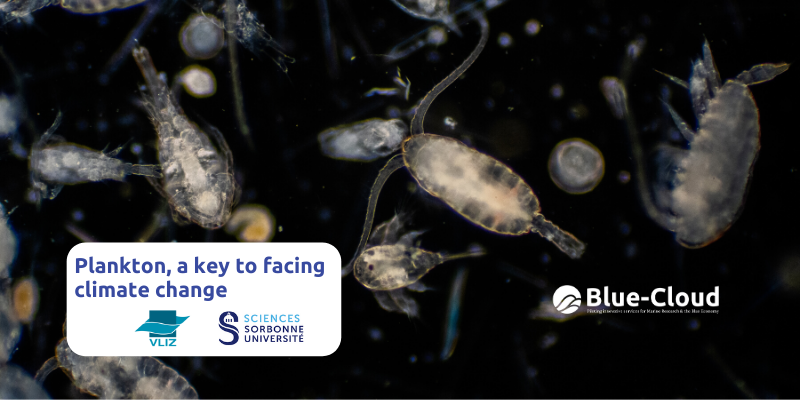The five Blue-Cloud pilot demonstrators work under the supervision of IFREMER, the French Research Institute for Exploitation of the Sea, and focus on different areas of marine science.
The demonstrator “Zoo and Phytoplankton EOV Products” is led by the Flanders Marine Institute (VLIZ) in collaboration with the Faculty of Sciences at Sorbonne University, and its focus is on biodiversity. The activities are centered on the biological Essential Ocean Variables (EOVs) on plankton. Plankton comprises an integral and vital component of the pelagic food web and is an important part of the marine ecosystem.
Among all of the oceanic variables to be measured, EOVs were underlined by the scientific community as crucial for ocean observation in a global context. They include ocean physics, biogeochemistry, ocean biology and ecosystems, and address the variables to be measured, the approach to measuring them, and how to manage and make available their data and products.
This Blue-Cloud demonstrator aims to obtain phytoplankton, zooplankton, and nutrients EOV products that contribute to improving our knowledge and reduce uncertainty regarding the state of marine plankton ecosystems, as well as their response to ongoing and future climate change. It will compile and process several data resources that are currently available under different European marine networks, data systems, and research infrastructures, applying big data analysis and machine learning methods to create fit for purpose data products.
The current landscape
The global description of the abundance and diversity of phytoplankton communities yields an indication of the health of marine ecosystems and their response to anthropic stressors.
EOVs aim at rationalizing data collection, facilitate data dissemination and maximize data utilization. As biological EOVs on phytoplankton and zooplankton are still in the conceptual or pilot phase, this demonstrator will contribute directly to their further development and application on large scales.
As of the moment, machine learning-based algorithms are available, have been tested at a limited scale as part of EMODnet Biology for the zooplankton products, or at a global scale for the phytoplankton and nutrients models. Moreover, these new products will integrate a number of different data sources: from in-situ plankton counts, global Argo float data to Copernicus satellite imagery. These data sources exist but are not always easily accessible, thus combining these sources to create products is currently not possible in an efficient way.

The Blue-Cloud added-value
The proposed demonstrator will build upon a range of oceanographic data from multiple streams, made interoperable and integrated through Blue-Cloud in one single environment, in order to produce unique 3D and 4D synergistic zooplankton and phytoplankton products that will be made available to end-users.
Thanks to the Blue-Cloud interface, the demonstrator will implement a workflow to apply big data analysis and machine learning (e.g. neural networks) methods on multi-source data sets. The framework will include a ground truth model using near real-time data from LifeWatch data. The resulting workflow will be published as a Blue-Cloud Virtual Lab, and results will be exploited through dissemination in the policy advisory process.
The following datasets will be used in the pilot Blue-Cloud plankton demonstrator:
- EurOBIS data, in particular the Continuous Plankton Recorder dataset from the UK Marine Biological Association.
- Biogeochemical Argo data.
- Copernicus satellite data and products.
Data products showing spatial trends and long term anomalies in abundances of phytoplankton and zooplankton provide an exemplary illustration of the dynamics of food availability for commercially exploited fish species.
This demonstrator also addresses some of the priorities highlighted in the EC Marine Strategy Framework Directive, as plankton indicators are used within several of its descriptors (D1: Biodiversity; D4: Food webs; D6: Sea Floor Integrity; D5: Eutrophication).
Hear directly from Lennert Schepers (Project Manager - VLIZ) and Lennert Tyberghein (Head of Data Centre - VLIZ).
Discover the Zoo and Phytoplankton EOV Demonstrator
